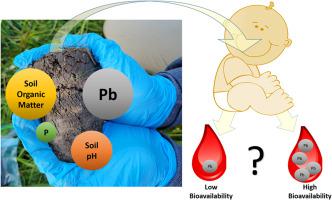当前位置:
X-MOL 学术
›
Appl. Geochem.
›
论文详情
Our official English website, www.x-mol.net, welcomes your feedback! (Note: you will need to create a separate account there.)
Lead bioaccessibility and commonly measured soil characteristics in Detroit, Michigan
Applied Geochemistry ( IF 3.4 ) Pub Date : 2024-03-25 , DOI: 10.1016/j.apgeochem.2024.105978 Sabrina R. Good , Allison R. Harris , Patrick Crouch , Conor T. Gowan , William D. Shuster , Shawn P. McElmurry
Applied Geochemistry ( IF 3.4 ) Pub Date : 2024-03-25 , DOI: 10.1016/j.apgeochem.2024.105978 Sabrina R. Good , Allison R. Harris , Patrick Crouch , Conor T. Gowan , William D. Shuster , Shawn P. McElmurry

|
Historical and contemporary use of lead (Pb) in gasoline, paints, and industry have led to its concentration in urban soils, presenting a human health risk, with disproportionate impacts on children living in urban areas. Contaminated soil is one of the major contributors to child Pb exposure. While many residents practicing urban agriculture have their soil tested to determine the amount of soil total Pb present, this measure does not provide a direct indicator of soil Pb bioaccessibility (used to predict bioavailability). Because bioavailability is ultimately necessary to determine the exposure risk, we aimed to gain a more refined understanding of Pb risk using measurements commonly performed as part of typical agricultural soil tests. Accordingly, we sampled soils from 142 residential parcels located in Detroit, MI. Soils were evaluated for: pH, organic matter content, cation exchange capacity, phosphorus, sulfur, calcium, potassium, magnesium, and sodium and total and bioaccessible (IVBA) Pb. Detroit soil IVBA Pb ranged from 4.5% to 81%, with a mean of 39%. Total Pb, organic matter (OM) content and soil pH were found to be the most important predictors of Pb bioaccessibility. Soils typically had a relatively low OM content (mean of 5%) however, samples with higher OM content had lower IVBA (e.g., the IVBA was 15.2% smaller in soils with 7.5% OM). Soils were typically slightly basic (mean of 7.8); however, samples with pH closer to neutral had lower IVBA (e.g., the IVBA was 11.6% smaller in soils with a pH of 7.3). The proximity of soil sampling locations to former smelter locations was also found to influence Pb bioaccessibility, with samples closer to former Pb smelter sites having a somewhat higher average IVBA. Results suggest increasing soil OM content in urban soils will reduce Pb bioaccessibility. Building soil OM would therefore improve both soil fertility and decrease soil Pb bioaccessibility, imparting a predicted decrease in exposure risks.
中文翻译:

密歇根州底特律的铅生物可及性和常用测量土壤特征
历史和当代汽油、油漆和工业中铅 (Pb) 的使用导致其集中在城市土壤中,对人类健康构成威胁,对城市地区儿童的影响尤为严重。受污染的土壤是儿童接触铅的主要原因之一。虽然许多从事城市农业的居民对土壤进行了测试,以确定土壤中总铅的含量,但这一措施并不能提供土壤铅生物可利用性的直接指标(用于预测生物有效性)。由于生物利用度最终是确定暴露风险所必需的,因此我们旨在通过通常作为典型农业土壤测试一部分进行的测量来更深入地了解铅风险。因此,我们对位于密歇根州底特律的 142 个住宅区的土壤进行了采样。土壤评估包括:pH、有机质含量、阳离子交换能力、磷、硫、钙、钾、镁和钠以及总铅和生物可利用 (IVBA) 铅。底特律土壤 IVBA Pb 含量范围为 4.5% 至 81%,平均值为 39%。研究发现总 Pb、有机质 (OM) 含量和土壤 pH 值是 Pb 生物可利用性最重要的预测因子。土壤通常具有相对较低的 OM 含量(平均值为 5%),但 OM 含量较高的样品具有较低的 IVBA(例如,在 7.5% OM 的土壤中,IVBA 小 15.2%)。土壤通常呈弱碱性(平均值为 7.8);然而,pH值接近中性的样品的IVBA较低(例如,pH值为7.3的土壤中的IVBA小11.6%)。土壤采样地点与前冶炼厂地点的接近程度也被发现会影响铅的生物可及性,靠近前铅冶炼厂地点的样品具有较高的平均 IVBA。结果表明,增加城市土壤中的有机质含量将降低铅的生物可利用性。因此,建设土壤有机肥将提高土壤肥力并降低土壤铅的生物可及性,从而预计会降低暴露风险。
更新日期:2024-03-25
中文翻译:

密歇根州底特律的铅生物可及性和常用测量土壤特征
历史和当代汽油、油漆和工业中铅 (Pb) 的使用导致其集中在城市土壤中,对人类健康构成威胁,对城市地区儿童的影响尤为严重。受污染的土壤是儿童接触铅的主要原因之一。虽然许多从事城市农业的居民对土壤进行了测试,以确定土壤中总铅的含量,但这一措施并不能提供土壤铅生物可利用性的直接指标(用于预测生物有效性)。由于生物利用度最终是确定暴露风险所必需的,因此我们旨在通过通常作为典型农业土壤测试一部分进行的测量来更深入地了解铅风险。因此,我们对位于密歇根州底特律的 142 个住宅区的土壤进行了采样。土壤评估包括:pH、有机质含量、阳离子交换能力、磷、硫、钙、钾、镁和钠以及总铅和生物可利用 (IVBA) 铅。底特律土壤 IVBA Pb 含量范围为 4.5% 至 81%,平均值为 39%。研究发现总 Pb、有机质 (OM) 含量和土壤 pH 值是 Pb 生物可利用性最重要的预测因子。土壤通常具有相对较低的 OM 含量(平均值为 5%),但 OM 含量较高的样品具有较低的 IVBA(例如,在 7.5% OM 的土壤中,IVBA 小 15.2%)。土壤通常呈弱碱性(平均值为 7.8);然而,pH值接近中性的样品的IVBA较低(例如,pH值为7.3的土壤中的IVBA小11.6%)。土壤采样地点与前冶炼厂地点的接近程度也被发现会影响铅的生物可及性,靠近前铅冶炼厂地点的样品具有较高的平均 IVBA。结果表明,增加城市土壤中的有机质含量将降低铅的生物可利用性。因此,建设土壤有机肥将提高土壤肥力并降低土壤铅的生物可及性,从而预计会降低暴露风险。



























 京公网安备 11010802027423号
京公网安备 11010802027423号